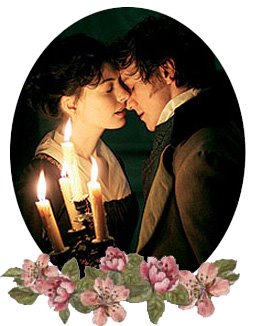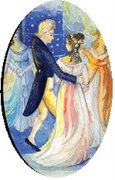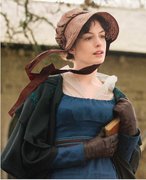 Don’t be deceived by this picture of Henry Austen. Henry was definitely more cheerful than his expression here, particularly during his youth. He was charming and quite a good talker, that man. An attractive young lad and the fact that he was a member of Oxford militia (hence had the honour of wearing a scarlet uniform) did nothing to reduce his charms. Why, Jane even called his arrival ‘put life and wit into the party’ (Chapman 1949, p. 15).
Don’t be deceived by this picture of Henry Austen. Henry was definitely more cheerful than his expression here, particularly during his youth. He was charming and quite a good talker, that man. An attractive young lad and the fact that he was a member of Oxford militia (hence had the honour of wearing a scarlet uniform) did nothing to reduce his charms. Why, Jane even called his arrival ‘put life and wit into the party’ (Chapman 1949, p. 15).
Yes…Henry Austen was Jane’s favourite brother, the was Edward Austen was to Cassandra (Chapman 1949). In the Memoir of Jane Austen, Caroline Austen called Henry as Jane’s ‘especial pride and delight’. Indeed, she acknowledged his mischievousness, but in a loving way. In fact, ‘Oh, what a Henry!’ was her comment on him as she wrote to Cassandra on June 23, 1814 (Letter 23).
Henry Austen was born on June 8, 1771 in Steventon as the fourth child of Revd George Austen and Mrs. Cassandra Austen (nee Leigh). In 1788, Henry took his education in St. John’s College in Oxford and joined the Oxford Militia in 1793. Henry used to be engaged too a Miss Pearson (Chapman 1949) before marrying his cousin Eliza de Feullide in 1797, to whom he often flirted despite the fact that he was ten years younger than the Countess. This marriage, a very important episode of his life, was not recorded in Jane Austen’s surviving letters, for the entire letters of year 1797 were gone (most likely were burnt by Cassandra).

After marrying Eliza, Henry went to Ireland with his regiment in March 1799 (Tomalin 2000). And see this: there was no surviving JA letters after January 21st, 1799 (Letter 18) until before May 17th, 1799 (letter 19). Henry went to Ireland on March 1799; you would think that Jane would talk a lot of his departure and awaited adventures in Ireland. She would talk of how he settled in Ireland and all those things a sister would ask when her brother went overseas. But there was a four months gap of no letters. What happened?
Let me offer an explanation here: Tom Lefroy married Mary Paul on March 16, 1799 in North Wales, England (Lefroy 1871). The wedding was conducted in England because Ireland at that time was not considered safe, due to the Rebellion in Ireland. Did Jane learn of this marriage, hence the absence of letters for four months?
Also, if Henry indeed met Tom in Ireland after Tom’s wedding (I'm not sure when Tom returned to Ireland after his marriage in Wales), Henry would have many things to tell his sister Jane. And, of course, Jane would relay the news to Cassandra…who later would think that the letters were too dangerous to be around (Thanks to Arnie for his tips re: Henry’s visit to Ireland).
We can find Jane’s correspondence later from May 17th to June 19th 1799 (letter 22). Then, for more than a year until 25th of October 1800 (letter 23), no surviving letter of JA was found. What if in those days JA indeed discussed Tom’s marriage with Henry or Cassandra? And why there was such a huge gap? If Henry/Eliza/Cassandra/Jane talked about Tom in only a few letters… there was no need to extinguish letters of the entire sixteen months.
Henry Austen stayed in Ireland until October/November 1799. A lot of things could happen in seven months that Henry might tell Jane in his letters that Jane (again) communicated to Cassandra. More reasons for Cass to confiscate the letters (with all due respect to sister Cass, of course), and more wish from my side that we have Henry’s surviving letters (which is not the case, unfortunately). For the rest of the year 1799 and January to October 1800, I have no explanation for that.
In page 37 of the Memoir of Chief Justice Lefroy, the young Thomas Lefroy (Tom Lefroy’s son) mentioned that his father (the original Tom Lefroy) loved County Wicklow (Lefroy 1871). Coincidentally, the BJ filmmakers chose it as the BJ location, apparently independent of the knowledge (I might be wrong, but Julian Jarrold would NOT conceal such an important matter). Okay, what does it have to do with Henry Austen?

Now, perhaps Henry still had grudges over Tom for what happened between the Irish lad and his sister. But they were friends after all, and I am sure that both were capable of setting aside the past and at least talked out of respect. And what if (one of) the place(s) was somewhere in Wicklow, when both lads would talk of things… including of Jane? That would be a good reason for Tom to spend time in Wicklow contemplating, especially if Wicklow bore a resemblance with Hampshire (the feeling that Julian Jarrold &c caught more than two hundred years later). For the record, Tom Lefroy indeed wrote many letters to his wife (and I do believe that he loved her... but he still could not forget Jane Austen entirely), but all letters were dated 1810 and beyond. None predated 1810, let alone 1799. It is also interesting to note that Chief Justice Tom Lefroy spent the three last years of his life in Bray, County Wicklow, Ireland, in a villa of Newcourt he rented in 1866. He died there as well on May 4th, 1869 (Lefroy, 1871, p. 382).
Anyway, Henry apparently enjoyed his stay in Ireland, although he had to occasionally attended the boring parties of the Viceroy (Lord Cornwallis) and Lord Spencer (Nokes 1997; Tomalin 2000). And yes, this Spencer was the ancestor of the late Lady Diana of Wales (thanks Arnie!). But then, it seemed that Eliza (who once thought of moving to Ireland as well) asked him to return to London. After the faithful vague Ireland episodes in 1799, Henry returned to London. He left the Militia in 1801 and became a banker and Army agent in London. He first lived in Upper Berkeley Street, his office was in Cleveland Court (Chapman 1949). Henry and Eliza then moved to Brompton, and later to Sloane Street. Henry was quite prosperous; he became Receiver-General for Oxfordshire in 1813, the year Eliza de Feullide died. After his wife’s death, Henry moved to Henrietta St. Later on, he married Eleanor Jackson, but still without any offspring.

On March 15, 1816, Henry’s bank failed and he left London to Oxford to become a clergyman. He was ordained in December 1816 and became curator of Chawton. In fact, Jane told her nephew that ‘Uncle Henry writes very superior sermons’ (Letter 134).
A very caring brother, Henry helped Jane a lot with the publications of her books. Henry sold Susan to Crosby & Co in 1803 (for £10). In 1811, Jane stayed with him and Eliza in London to finish Sense & Sensibility. Henry also supervised Mansfield Park in 1814 (and found it ‘extremely interesting’ – Letter March 9, 1814). After Jane’s death on July 18th 1817, Henry with the help of Cassandra published the two last books of Jane; Northanger Abbey and Persuasion.
Henry Austen died in 1850 without leaving any descendants or any letters between him and his sister Jane. So unfortunate, for I truly believe that we can learn more of Jane Austen (and Tom Lefroy!) from Henry’s letters.
By the way, Becoming Jane has a discrepancy with Eliza’s death, for by the time Jane met Tom Lefroy in London in 1815/16 (in the movie only, not known in real life), Eliza was still around with Henry. But I like the fact that Jane was a bit pissed off because she thought that Henry and Eliza somehow orchestrated the meeting with Tom. In real life, I think there is a possibility that Henry actually did more than just strolling Ireland in 1799… but we might never know what he did then.
Oh, and I just learned that Becoming Jane was filmed in Killruddery in Bray, County Wicklow! (See also the post from Austenblog). Austenblog also said that BJ was shot in Ardmore Studio, just outside Bray. Bray, the place where the real Tom Lefroy died. Okay, make me a liar, guys... but it's rather spooky! No wonder it rained almost all the time!
Reference: Chapman, R. W. 1949, Jane Austen: Facts and Problems, Oxford University Press, reprint from 1948, Oxford.
Chapman, R. W. 1979, Jane Austen's Letters to Her Sister Cassandra and Others, 2nd edn, Oxford University Press, Oxford.
Lefroy, T. 1871, Memoir of Chief Justice Lefroy, Hodges, Foster & Co., Dublin.
Nokes, D. 1997, Jane Austen: A Life, Fourth Estate, London.
Tomalin, C. 2000, Jane Austen: A Life, Penguin Books, London.
Pic 1: Henry Austen, c 1820 (from Memoir of Jane Austen)
Pic 2: Henry's wedding with Eliza de Feullide (Jane Austen Regency World Magazine)
Pic 3: Tom Lefroy (James McAvoy) and Henry Austen (Joe Anderson) in 'Becoming Jane'
Pic 4: Jane Austen (Anne Hathaway), Eliza de Feullide (Lucy Cohu) and Henry Austen in 'Becoming Jane'
 Don’t be deceived by this picture of Henry Austen. Henry was definitely more cheerful than his expression here, particularly during his youth. He was charming and quite a good talker, that man. An attractive young lad and the fact that he was a member of
Don’t be deceived by this picture of Henry Austen. Henry was definitely more cheerful than his expression here, particularly during his youth. He was charming and quite a good talker, that man. An attractive young lad and the fact that he was a member of 














































3 comments:
There is so much to this post Icha! Alot of speculation but with that speculation, there is therefore alot of potential scenarios. With all that time in Ireland, I cannot believe that Henry did not visit Tom and if he did, there is no doubt that Jane would have been mentioned. The mind wanders! You are right though, how wonderful would it be if more letters existed from this time? But why dont they? I feel that this is the greatest mystery!
The factual basis of Henry's biography is great as always Icha, so much detail and a brilliant read. Thank you!
Heheh! Guilty as charged... I should not mix the Henry/Tom post with Henry's bio, but I cannot resist it. Also, when I wrote it, I did not realise that the BJ location was in BRAY. Excuses, excuses...
I will make a more comprehensive post of the Bray thing after I gain more data. Meanwhile, have a good night and thanks!
You were right - so fascinating! I can't wait to dive deeper!
Post a Comment